Organisational Change and Transformation Report for JI India
VerifiedAdded on 2022/12/26
|14
|4708
|79
Report
AI Summary
This report provides a comprehensive analysis of the change and transformation challenges faced by Jobs International (India) Ltd (JI India). It begins with recommendations for Mr. Jacob, the owner, focusing on areas such as organizational culture, hierarchy, and employee engagement, while also addressing potential obstacles like undue employee advantages and lack of internal innovation. The report then details the actions taken by Jacob in response to a consultant's report, including adjustments to organizational culture, implementation of a hierarchical structure, and adoption of transformational and democratic leadership styles, as well as changes to the motivation and reward system. The report also considers the obstacles that may arise from these strategies, such as poor decision-making and reactive behaviors, and suggests solutions like training. Furthermore, the report employs organizational change management theories, including McKinsey 7S and Lewin's 3-stage model, to provide a structured approach to the company's transformation. The report concludes with the actions taken by the managing director of JI India, alongside anticipated obstacles and proposed mitigation strategies, offering a holistic view of the change management process at JI India.
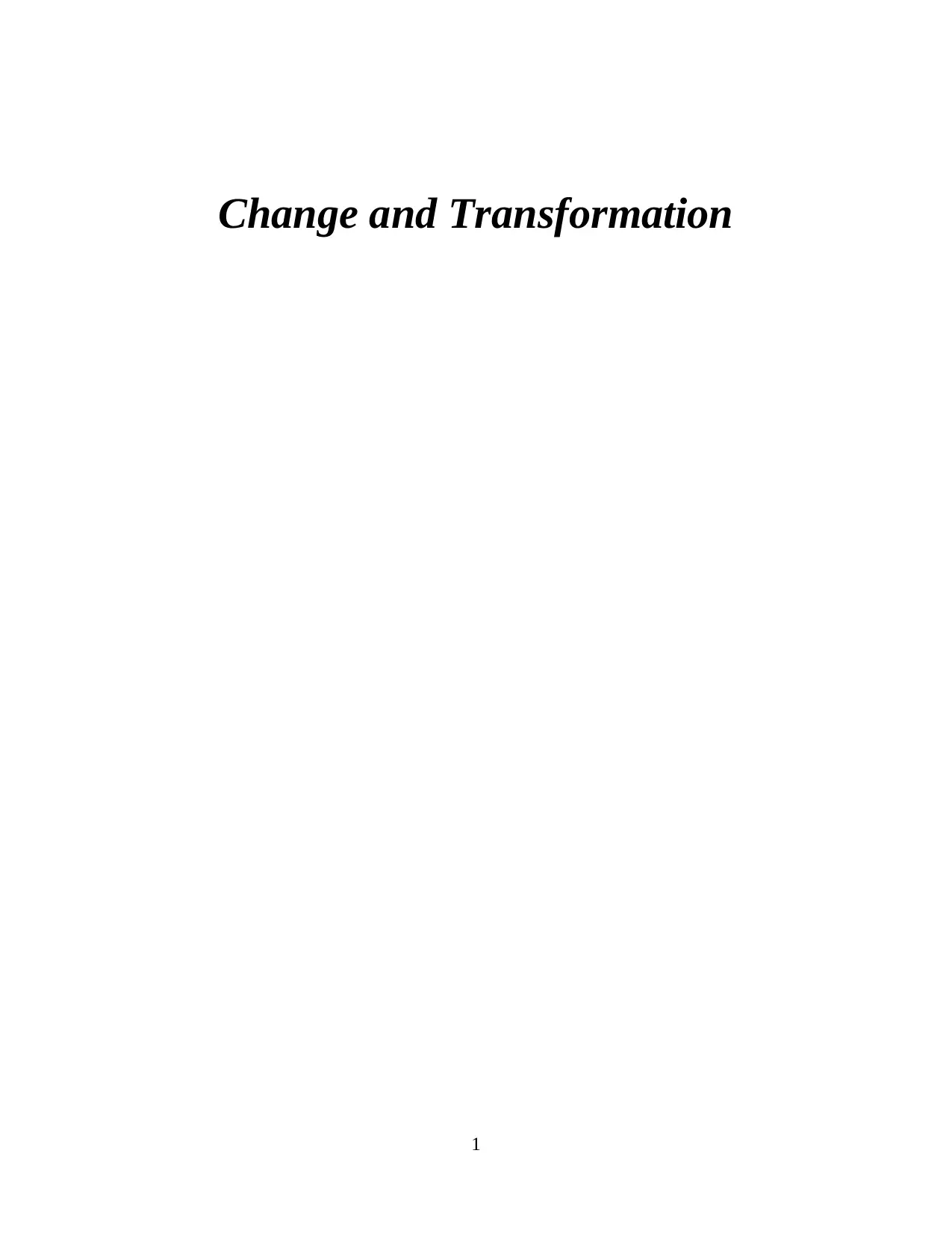
Change and Transformation
1
1
Paraphrase This Document
Need a fresh take? Get an instant paraphrase of this document with our AI Paraphraser
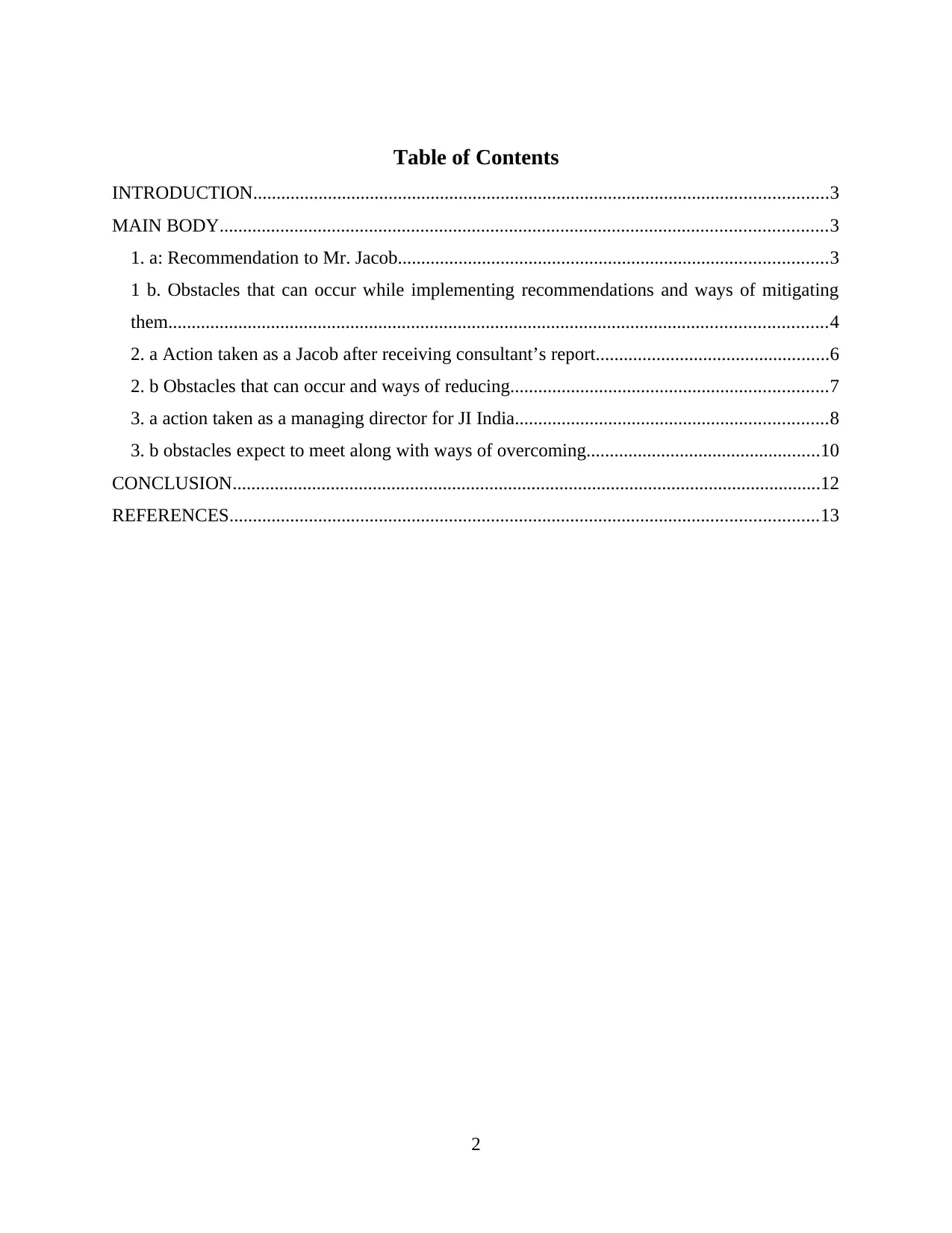
Table of Contents
INTRODUCTION...........................................................................................................................3
MAIN BODY..................................................................................................................................3
1. a: Recommendation to Mr. Jacob............................................................................................3
1 b. Obstacles that can occur while implementing recommendations and ways of mitigating
them.............................................................................................................................................4
2. a Action taken as a Jacob after receiving consultant’s report..................................................6
2. b Obstacles that can occur and ways of reducing....................................................................7
3. a action taken as a managing director for JI India...................................................................8
3. b obstacles expect to meet along with ways of overcoming..................................................10
CONCLUSION..............................................................................................................................12
REFERENCES..............................................................................................................................13
2
INTRODUCTION...........................................................................................................................3
MAIN BODY..................................................................................................................................3
1. a: Recommendation to Mr. Jacob............................................................................................3
1 b. Obstacles that can occur while implementing recommendations and ways of mitigating
them.............................................................................................................................................4
2. a Action taken as a Jacob after receiving consultant’s report..................................................6
2. b Obstacles that can occur and ways of reducing....................................................................7
3. a action taken as a managing director for JI India...................................................................8
3. b obstacles expect to meet along with ways of overcoming..................................................10
CONCLUSION..............................................................................................................................12
REFERENCES..............................................................................................................................13
2
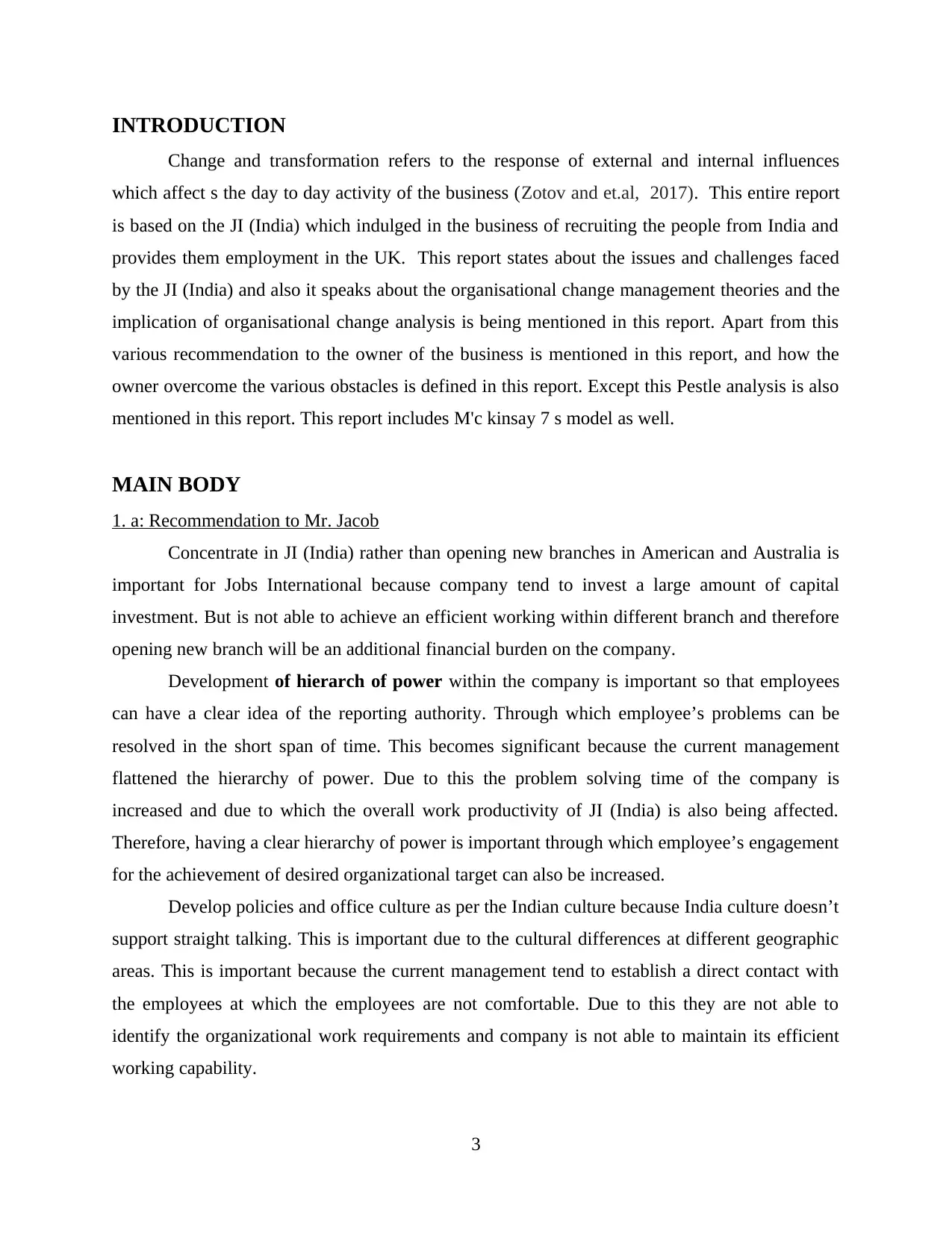
INTRODUCTION
Change and transformation refers to the response of external and internal influences
which affect s the day to day activity of the business (Zotov and et.al, 2017). This entire report
is based on the JI (India) which indulged in the business of recruiting the people from India and
provides them employment in the UK. This report states about the issues and challenges faced
by the JI (India) and also it speaks about the organisational change management theories and the
implication of organisational change analysis is being mentioned in this report. Apart from this
various recommendation to the owner of the business is mentioned in this report, and how the
owner overcome the various obstacles is defined in this report. Except this Pestle analysis is also
mentioned in this report. This report includes M'c kinsay 7 s model as well.
MAIN BODY
1. a: Recommendation to Mr. Jacob
Concentrate in JI (India) rather than opening new branches in American and Australia is
important for Jobs International because company tend to invest a large amount of capital
investment. But is not able to achieve an efficient working within different branch and therefore
opening new branch will be an additional financial burden on the company.
Development of hierarch of power within the company is important so that employees
can have a clear idea of the reporting authority. Through which employee’s problems can be
resolved in the short span of time. This becomes significant because the current management
flattened the hierarchy of power. Due to this the problem solving time of the company is
increased and due to which the overall work productivity of JI (India) is also being affected.
Therefore, having a clear hierarchy of power is important through which employee’s engagement
for the achievement of desired organizational target can also be increased.
Develop policies and office culture as per the Indian culture because India culture doesn’t
support straight talking. This is important due to the cultural differences at different geographic
areas. This is important because the current management tend to establish a direct contact with
the employees at which the employees are not comfortable. Due to this they are not able to
identify the organizational work requirements and company is not able to maintain its efficient
working capability.
3
Change and transformation refers to the response of external and internal influences
which affect s the day to day activity of the business (Zotov and et.al, 2017). This entire report
is based on the JI (India) which indulged in the business of recruiting the people from India and
provides them employment in the UK. This report states about the issues and challenges faced
by the JI (India) and also it speaks about the organisational change management theories and the
implication of organisational change analysis is being mentioned in this report. Apart from this
various recommendation to the owner of the business is mentioned in this report, and how the
owner overcome the various obstacles is defined in this report. Except this Pestle analysis is also
mentioned in this report. This report includes M'c kinsay 7 s model as well.
MAIN BODY
1. a: Recommendation to Mr. Jacob
Concentrate in JI (India) rather than opening new branches in American and Australia is
important for Jobs International because company tend to invest a large amount of capital
investment. But is not able to achieve an efficient working within different branch and therefore
opening new branch will be an additional financial burden on the company.
Development of hierarch of power within the company is important so that employees
can have a clear idea of the reporting authority. Through which employee’s problems can be
resolved in the short span of time. This becomes significant because the current management
flattened the hierarchy of power. Due to this the problem solving time of the company is
increased and due to which the overall work productivity of JI (India) is also being affected.
Therefore, having a clear hierarchy of power is important through which employee’s engagement
for the achievement of desired organizational target can also be increased.
Develop policies and office culture as per the Indian culture because India culture doesn’t
support straight talking. This is important due to the cultural differences at different geographic
areas. This is important because the current management tend to establish a direct contact with
the employees at which the employees are not comfortable. Due to this they are not able to
identify the organizational work requirements and company is not able to maintain its efficient
working capability.
3
⊘ This is a preview!⊘
Do you want full access?
Subscribe today to unlock all pages.

Trusted by 1+ million students worldwide
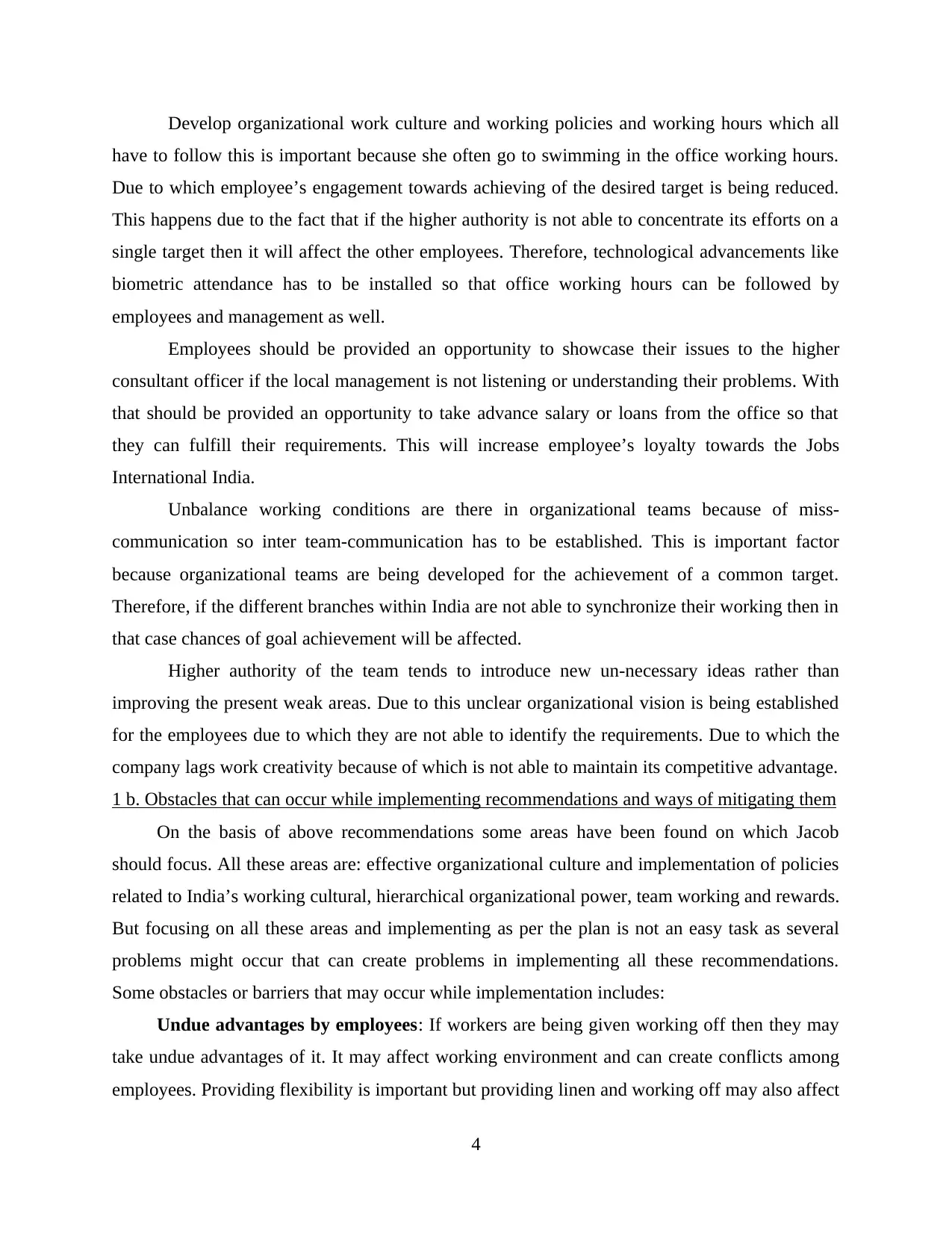
Develop organizational work culture and working policies and working hours which all
have to follow this is important because she often go to swimming in the office working hours.
Due to which employee’s engagement towards achieving of the desired target is being reduced.
This happens due to the fact that if the higher authority is not able to concentrate its efforts on a
single target then it will affect the other employees. Therefore, technological advancements like
biometric attendance has to be installed so that office working hours can be followed by
employees and management as well.
Employees should be provided an opportunity to showcase their issues to the higher
consultant officer if the local management is not listening or understanding their problems. With
that should be provided an opportunity to take advance salary or loans from the office so that
they can fulfill their requirements. This will increase employee’s loyalty towards the Jobs
International India.
Unbalance working conditions are there in organizational teams because of miss-
communication so inter team-communication has to be established. This is important factor
because organizational teams are being developed for the achievement of a common target.
Therefore, if the different branches within India are not able to synchronize their working then in
that case chances of goal achievement will be affected.
Higher authority of the team tends to introduce new un-necessary ideas rather than
improving the present weak areas. Due to this unclear organizational vision is being established
for the employees due to which they are not able to identify the requirements. Due to which the
company lags work creativity because of which is not able to maintain its competitive advantage.
1 b. Obstacles that can occur while implementing recommendations and ways of mitigating them
On the basis of above recommendations some areas have been found on which Jacob
should focus. All these areas are: effective organizational culture and implementation of policies
related to India’s working cultural, hierarchical organizational power, team working and rewards.
But focusing on all these areas and implementing as per the plan is not an easy task as several
problems might occur that can create problems in implementing all these recommendations.
Some obstacles or barriers that may occur while implementation includes:
Undue advantages by employees: If workers are being given working off then they may
take undue advantages of it. It may affect working environment and can create conflicts among
employees. Providing flexibility is important but providing linen and working off may also affect
4
have to follow this is important because she often go to swimming in the office working hours.
Due to which employee’s engagement towards achieving of the desired target is being reduced.
This happens due to the fact that if the higher authority is not able to concentrate its efforts on a
single target then it will affect the other employees. Therefore, technological advancements like
biometric attendance has to be installed so that office working hours can be followed by
employees and management as well.
Employees should be provided an opportunity to showcase their issues to the higher
consultant officer if the local management is not listening or understanding their problems. With
that should be provided an opportunity to take advance salary or loans from the office so that
they can fulfill their requirements. This will increase employee’s loyalty towards the Jobs
International India.
Unbalance working conditions are there in organizational teams because of miss-
communication so inter team-communication has to be established. This is important factor
because organizational teams are being developed for the achievement of a common target.
Therefore, if the different branches within India are not able to synchronize their working then in
that case chances of goal achievement will be affected.
Higher authority of the team tends to introduce new un-necessary ideas rather than
improving the present weak areas. Due to this unclear organizational vision is being established
for the employees due to which they are not able to identify the requirements. Due to which the
company lags work creativity because of which is not able to maintain its competitive advantage.
1 b. Obstacles that can occur while implementing recommendations and ways of mitigating them
On the basis of above recommendations some areas have been found on which Jacob
should focus. All these areas are: effective organizational culture and implementation of policies
related to India’s working cultural, hierarchical organizational power, team working and rewards.
But focusing on all these areas and implementing as per the plan is not an easy task as several
problems might occur that can create problems in implementing all these recommendations.
Some obstacles or barriers that may occur while implementation includes:
Undue advantages by employees: If workers are being given working off then they may
take undue advantages of it. It may affect working environment and can create conflicts among
employees. Providing flexibility is important but providing linen and working off may also affect
4
Paraphrase This Document
Need a fresh take? Get an instant paraphrase of this document with our AI Paraphraser
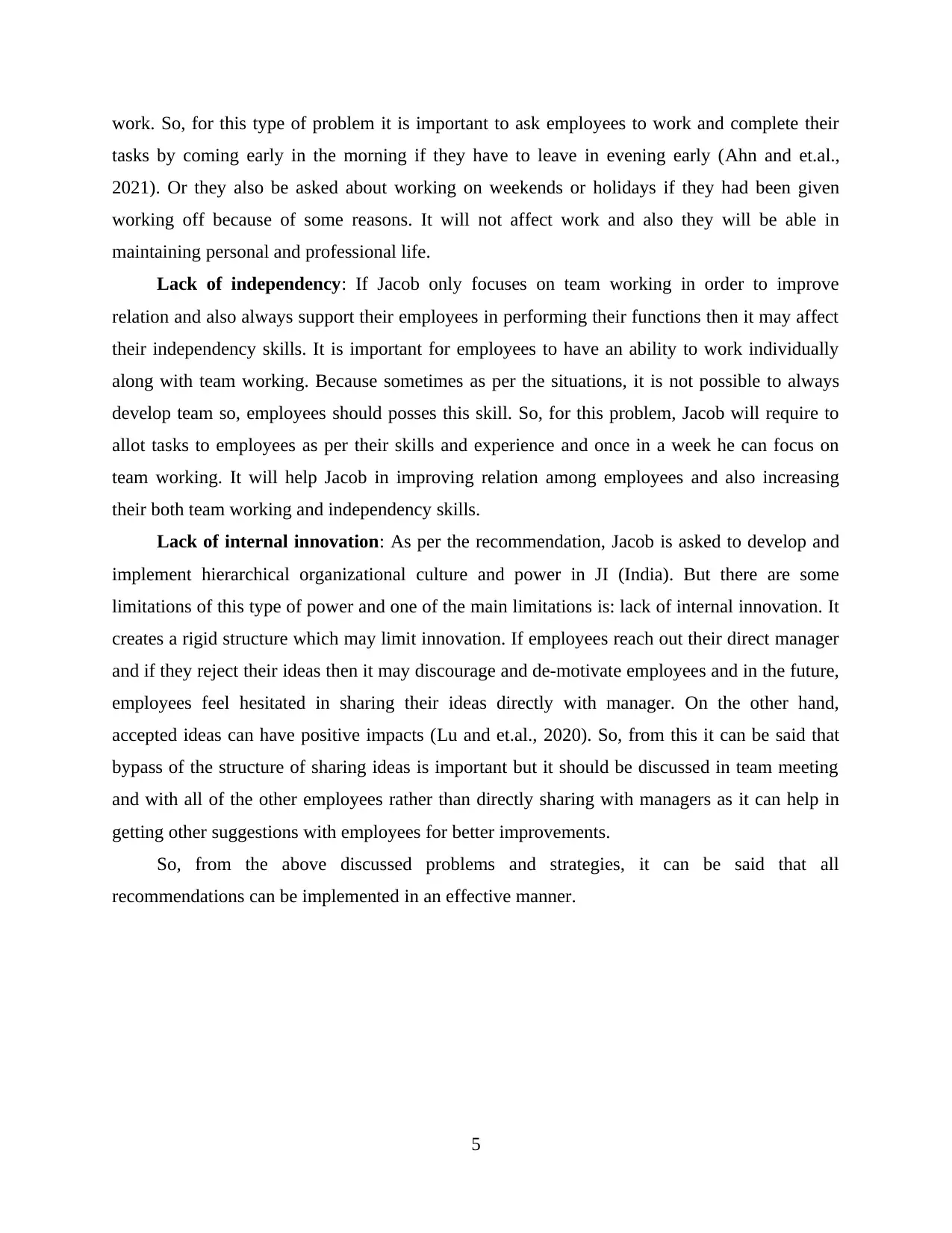
work. So, for this type of problem it is important to ask employees to work and complete their
tasks by coming early in the morning if they have to leave in evening early (Ahn and et.al.,
2021). Or they also be asked about working on weekends or holidays if they had been given
working off because of some reasons. It will not affect work and also they will be able in
maintaining personal and professional life.
Lack of independency: If Jacob only focuses on team working in order to improve
relation and also always support their employees in performing their functions then it may affect
their independency skills. It is important for employees to have an ability to work individually
along with team working. Because sometimes as per the situations, it is not possible to always
develop team so, employees should posses this skill. So, for this problem, Jacob will require to
allot tasks to employees as per their skills and experience and once in a week he can focus on
team working. It will help Jacob in improving relation among employees and also increasing
their both team working and independency skills.
Lack of internal innovation: As per the recommendation, Jacob is asked to develop and
implement hierarchical organizational culture and power in JI (India). But there are some
limitations of this type of power and one of the main limitations is: lack of internal innovation. It
creates a rigid structure which may limit innovation. If employees reach out their direct manager
and if they reject their ideas then it may discourage and de-motivate employees and in the future,
employees feel hesitated in sharing their ideas directly with manager. On the other hand,
accepted ideas can have positive impacts (Lu and et.al., 2020). So, from this it can be said that
bypass of the structure of sharing ideas is important but it should be discussed in team meeting
and with all of the other employees rather than directly sharing with managers as it can help in
getting other suggestions with employees for better improvements.
So, from the above discussed problems and strategies, it can be said that all
recommendations can be implemented in an effective manner.
5
tasks by coming early in the morning if they have to leave in evening early (Ahn and et.al.,
2021). Or they also be asked about working on weekends or holidays if they had been given
working off because of some reasons. It will not affect work and also they will be able in
maintaining personal and professional life.
Lack of independency: If Jacob only focuses on team working in order to improve
relation and also always support their employees in performing their functions then it may affect
their independency skills. It is important for employees to have an ability to work individually
along with team working. Because sometimes as per the situations, it is not possible to always
develop team so, employees should posses this skill. So, for this problem, Jacob will require to
allot tasks to employees as per their skills and experience and once in a week he can focus on
team working. It will help Jacob in improving relation among employees and also increasing
their both team working and independency skills.
Lack of internal innovation: As per the recommendation, Jacob is asked to develop and
implement hierarchical organizational culture and power in JI (India). But there are some
limitations of this type of power and one of the main limitations is: lack of internal innovation. It
creates a rigid structure which may limit innovation. If employees reach out their direct manager
and if they reject their ideas then it may discourage and de-motivate employees and in the future,
employees feel hesitated in sharing their ideas directly with manager. On the other hand,
accepted ideas can have positive impacts (Lu and et.al., 2020). So, from this it can be said that
bypass of the structure of sharing ideas is important but it should be discussed in team meeting
and with all of the other employees rather than directly sharing with managers as it can help in
getting other suggestions with employees for better improvements.
So, from the above discussed problems and strategies, it can be said that all
recommendations can be implemented in an effective manner.
5
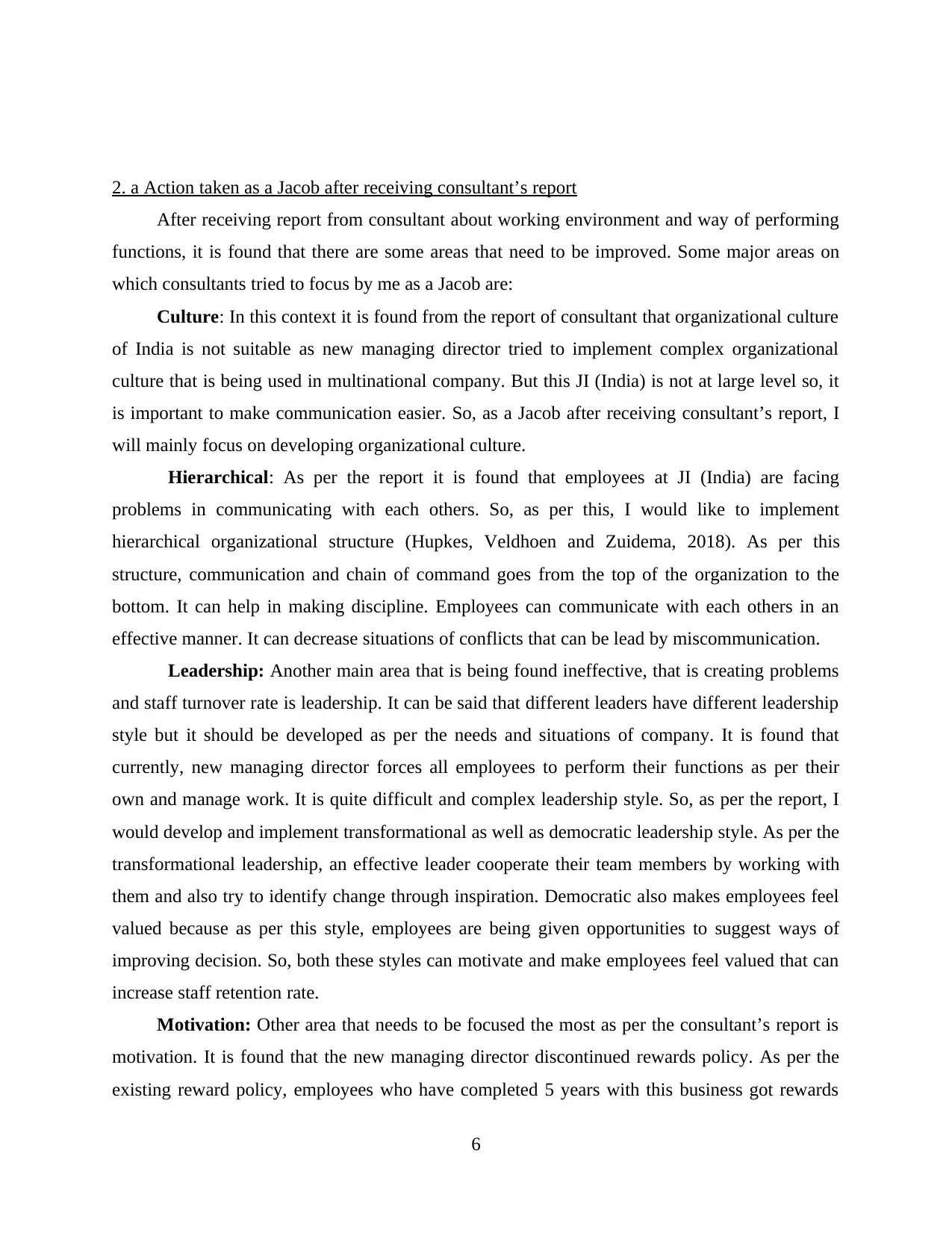
2. a Action taken as a Jacob after receiving consultant’s report
After receiving report from consultant about working environment and way of performing
functions, it is found that there are some areas that need to be improved. Some major areas on
which consultants tried to focus by me as a Jacob are:
Culture: In this context it is found from the report of consultant that organizational culture
of India is not suitable as new managing director tried to implement complex organizational
culture that is being used in multinational company. But this JI (India) is not at large level so, it
is important to make communication easier. So, as a Jacob after receiving consultant’s report, I
will mainly focus on developing organizational culture.
Hierarchical: As per the report it is found that employees at JI (India) are facing
problems in communicating with each others. So, as per this, I would like to implement
hierarchical organizational structure (Hupkes, Veldhoen and Zuidema, 2018). As per this
structure, communication and chain of command goes from the top of the organization to the
bottom. It can help in making discipline. Employees can communicate with each others in an
effective manner. It can decrease situations of conflicts that can be lead by miscommunication.
Leadership: Another main area that is being found ineffective, that is creating problems
and staff turnover rate is leadership. It can be said that different leaders have different leadership
style but it should be developed as per the needs and situations of company. It is found that
currently, new managing director forces all employees to perform their functions as per their
own and manage work. It is quite difficult and complex leadership style. So, as per the report, I
would develop and implement transformational as well as democratic leadership style. As per the
transformational leadership, an effective leader cooperate their team members by working with
them and also try to identify change through inspiration. Democratic also makes employees feel
valued because as per this style, employees are being given opportunities to suggest ways of
improving decision. So, both these styles can motivate and make employees feel valued that can
increase staff retention rate.
Motivation: Other area that needs to be focused the most as per the consultant’s report is
motivation. It is found that the new managing director discontinued rewards policy. As per the
existing reward policy, employees who have completed 5 years with this business got rewards
6
After receiving report from consultant about working environment and way of performing
functions, it is found that there are some areas that need to be improved. Some major areas on
which consultants tried to focus by me as a Jacob are:
Culture: In this context it is found from the report of consultant that organizational culture
of India is not suitable as new managing director tried to implement complex organizational
culture that is being used in multinational company. But this JI (India) is not at large level so, it
is important to make communication easier. So, as a Jacob after receiving consultant’s report, I
will mainly focus on developing organizational culture.
Hierarchical: As per the report it is found that employees at JI (India) are facing
problems in communicating with each others. So, as per this, I would like to implement
hierarchical organizational structure (Hupkes, Veldhoen and Zuidema, 2018). As per this
structure, communication and chain of command goes from the top of the organization to the
bottom. It can help in making discipline. Employees can communicate with each others in an
effective manner. It can decrease situations of conflicts that can be lead by miscommunication.
Leadership: Another main area that is being found ineffective, that is creating problems
and staff turnover rate is leadership. It can be said that different leaders have different leadership
style but it should be developed as per the needs and situations of company. It is found that
currently, new managing director forces all employees to perform their functions as per their
own and manage work. It is quite difficult and complex leadership style. So, as per the report, I
would develop and implement transformational as well as democratic leadership style. As per the
transformational leadership, an effective leader cooperate their team members by working with
them and also try to identify change through inspiration. Democratic also makes employees feel
valued because as per this style, employees are being given opportunities to suggest ways of
improving decision. So, both these styles can motivate and make employees feel valued that can
increase staff retention rate.
Motivation: Other area that needs to be focused the most as per the consultant’s report is
motivation. It is found that the new managing director discontinued rewards policy. As per the
existing reward policy, employees who have completed 5 years with this business got rewards
6
⊘ This is a preview!⊘
Do you want full access?
Subscribe today to unlock all pages.

Trusted by 1+ million students worldwide
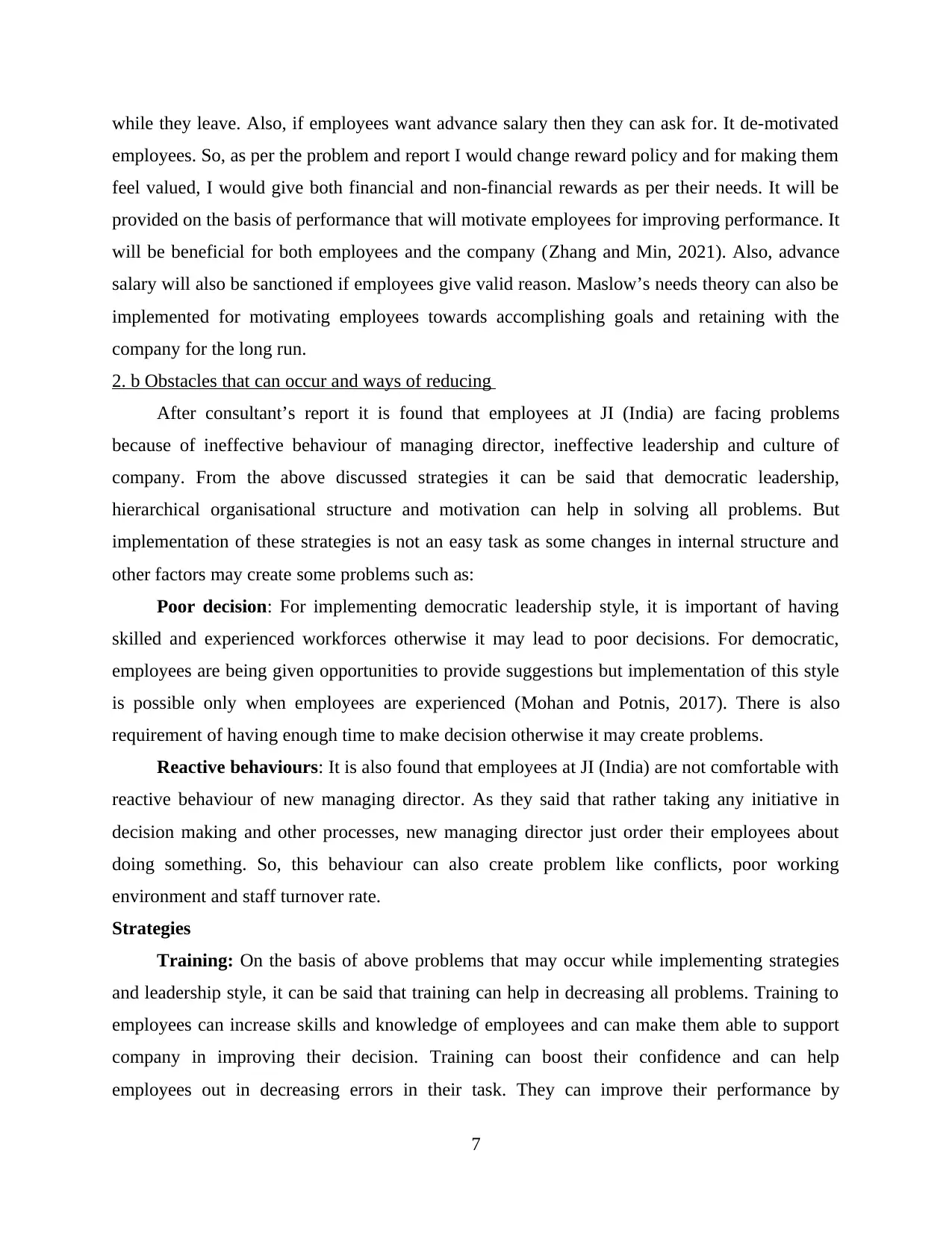
while they leave. Also, if employees want advance salary then they can ask for. It de-motivated
employees. So, as per the problem and report I would change reward policy and for making them
feel valued, I would give both financial and non-financial rewards as per their needs. It will be
provided on the basis of performance that will motivate employees for improving performance. It
will be beneficial for both employees and the company (Zhang and Min, 2021). Also, advance
salary will also be sanctioned if employees give valid reason. Maslow’s needs theory can also be
implemented for motivating employees towards accomplishing goals and retaining with the
company for the long run.
2. b Obstacles that can occur and ways of reducing
After consultant’s report it is found that employees at JI (India) are facing problems
because of ineffective behaviour of managing director, ineffective leadership and culture of
company. From the above discussed strategies it can be said that democratic leadership,
hierarchical organisational structure and motivation can help in solving all problems. But
implementation of these strategies is not an easy task as some changes in internal structure and
other factors may create some problems such as:
Poor decision: For implementing democratic leadership style, it is important of having
skilled and experienced workforces otherwise it may lead to poor decisions. For democratic,
employees are being given opportunities to provide suggestions but implementation of this style
is possible only when employees are experienced (Mohan and Potnis, 2017). There is also
requirement of having enough time to make decision otherwise it may create problems.
Reactive behaviours: It is also found that employees at JI (India) are not comfortable with
reactive behaviour of new managing director. As they said that rather taking any initiative in
decision making and other processes, new managing director just order their employees about
doing something. So, this behaviour can also create problem like conflicts, poor working
environment and staff turnover rate.
Strategies
Training: On the basis of above problems that may occur while implementing strategies
and leadership style, it can be said that training can help in decreasing all problems. Training to
employees can increase skills and knowledge of employees and can make them able to support
company in improving their decision. Training can boost their confidence and can help
employees out in decreasing errors in their task. They can improve their performance by
7
employees. So, as per the problem and report I would change reward policy and for making them
feel valued, I would give both financial and non-financial rewards as per their needs. It will be
provided on the basis of performance that will motivate employees for improving performance. It
will be beneficial for both employees and the company (Zhang and Min, 2021). Also, advance
salary will also be sanctioned if employees give valid reason. Maslow’s needs theory can also be
implemented for motivating employees towards accomplishing goals and retaining with the
company for the long run.
2. b Obstacles that can occur and ways of reducing
After consultant’s report it is found that employees at JI (India) are facing problems
because of ineffective behaviour of managing director, ineffective leadership and culture of
company. From the above discussed strategies it can be said that democratic leadership,
hierarchical organisational structure and motivation can help in solving all problems. But
implementation of these strategies is not an easy task as some changes in internal structure and
other factors may create some problems such as:
Poor decision: For implementing democratic leadership style, it is important of having
skilled and experienced workforces otherwise it may lead to poor decisions. For democratic,
employees are being given opportunities to provide suggestions but implementation of this style
is possible only when employees are experienced (Mohan and Potnis, 2017). There is also
requirement of having enough time to make decision otherwise it may create problems.
Reactive behaviours: It is also found that employees at JI (India) are not comfortable with
reactive behaviour of new managing director. As they said that rather taking any initiative in
decision making and other processes, new managing director just order their employees about
doing something. So, this behaviour can also create problem like conflicts, poor working
environment and staff turnover rate.
Strategies
Training: On the basis of above problems that may occur while implementing strategies
and leadership style, it can be said that training can help in decreasing all problems. Training to
employees can increase skills and knowledge of employees and can make them able to support
company in improving their decision. Training can boost their confidence and can help
employees out in decreasing errors in their task. They can improve their performance by
7
Paraphrase This Document
Need a fresh take? Get an instant paraphrase of this document with our AI Paraphraser
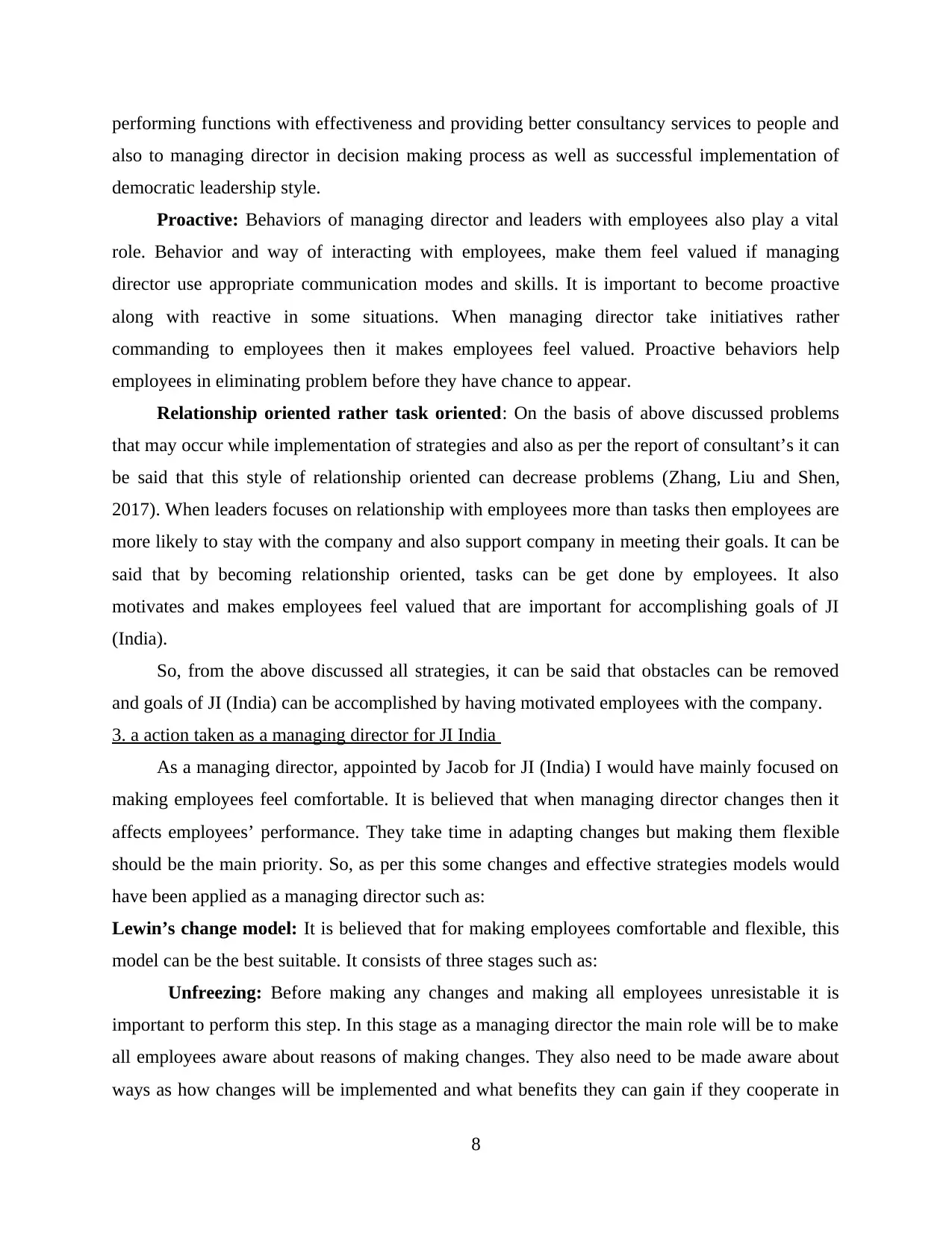
performing functions with effectiveness and providing better consultancy services to people and
also to managing director in decision making process as well as successful implementation of
democratic leadership style.
Proactive: Behaviors of managing director and leaders with employees also play a vital
role. Behavior and way of interacting with employees, make them feel valued if managing
director use appropriate communication modes and skills. It is important to become proactive
along with reactive in some situations. When managing director take initiatives rather
commanding to employees then it makes employees feel valued. Proactive behaviors help
employees in eliminating problem before they have chance to appear.
Relationship oriented rather task oriented: On the basis of above discussed problems
that may occur while implementation of strategies and also as per the report of consultant’s it can
be said that this style of relationship oriented can decrease problems (Zhang, Liu and Shen,
2017). When leaders focuses on relationship with employees more than tasks then employees are
more likely to stay with the company and also support company in meeting their goals. It can be
said that by becoming relationship oriented, tasks can be get done by employees. It also
motivates and makes employees feel valued that are important for accomplishing goals of JI
(India).
So, from the above discussed all strategies, it can be said that obstacles can be removed
and goals of JI (India) can be accomplished by having motivated employees with the company.
3. a action taken as a managing director for JI India
As a managing director, appointed by Jacob for JI (India) I would have mainly focused on
making employees feel comfortable. It is believed that when managing director changes then it
affects employees’ performance. They take time in adapting changes but making them flexible
should be the main priority. So, as per this some changes and effective strategies models would
have been applied as a managing director such as:
Lewin’s change model: It is believed that for making employees comfortable and flexible, this
model can be the best suitable. It consists of three stages such as:
Unfreezing: Before making any changes and making all employees unresistable it is
important to perform this step. In this stage as a managing director the main role will be to make
all employees aware about reasons of making changes. They also need to be made aware about
ways as how changes will be implemented and what benefits they can gain if they cooperate in
8
also to managing director in decision making process as well as successful implementation of
democratic leadership style.
Proactive: Behaviors of managing director and leaders with employees also play a vital
role. Behavior and way of interacting with employees, make them feel valued if managing
director use appropriate communication modes and skills. It is important to become proactive
along with reactive in some situations. When managing director take initiatives rather
commanding to employees then it makes employees feel valued. Proactive behaviors help
employees in eliminating problem before they have chance to appear.
Relationship oriented rather task oriented: On the basis of above discussed problems
that may occur while implementation of strategies and also as per the report of consultant’s it can
be said that this style of relationship oriented can decrease problems (Zhang, Liu and Shen,
2017). When leaders focuses on relationship with employees more than tasks then employees are
more likely to stay with the company and also support company in meeting their goals. It can be
said that by becoming relationship oriented, tasks can be get done by employees. It also
motivates and makes employees feel valued that are important for accomplishing goals of JI
(India).
So, from the above discussed all strategies, it can be said that obstacles can be removed
and goals of JI (India) can be accomplished by having motivated employees with the company.
3. a action taken as a managing director for JI India
As a managing director, appointed by Jacob for JI (India) I would have mainly focused on
making employees feel comfortable. It is believed that when managing director changes then it
affects employees’ performance. They take time in adapting changes but making them flexible
should be the main priority. So, as per this some changes and effective strategies models would
have been applied as a managing director such as:
Lewin’s change model: It is believed that for making employees comfortable and flexible, this
model can be the best suitable. It consists of three stages such as:
Unfreezing: Before making any changes and making all employees unresistable it is
important to perform this step. In this stage as a managing director the main role will be to make
all employees aware about reasons of making changes. They also need to be made aware about
ways as how changes will be implemented and what benefits they can gain if they cooperate in
8
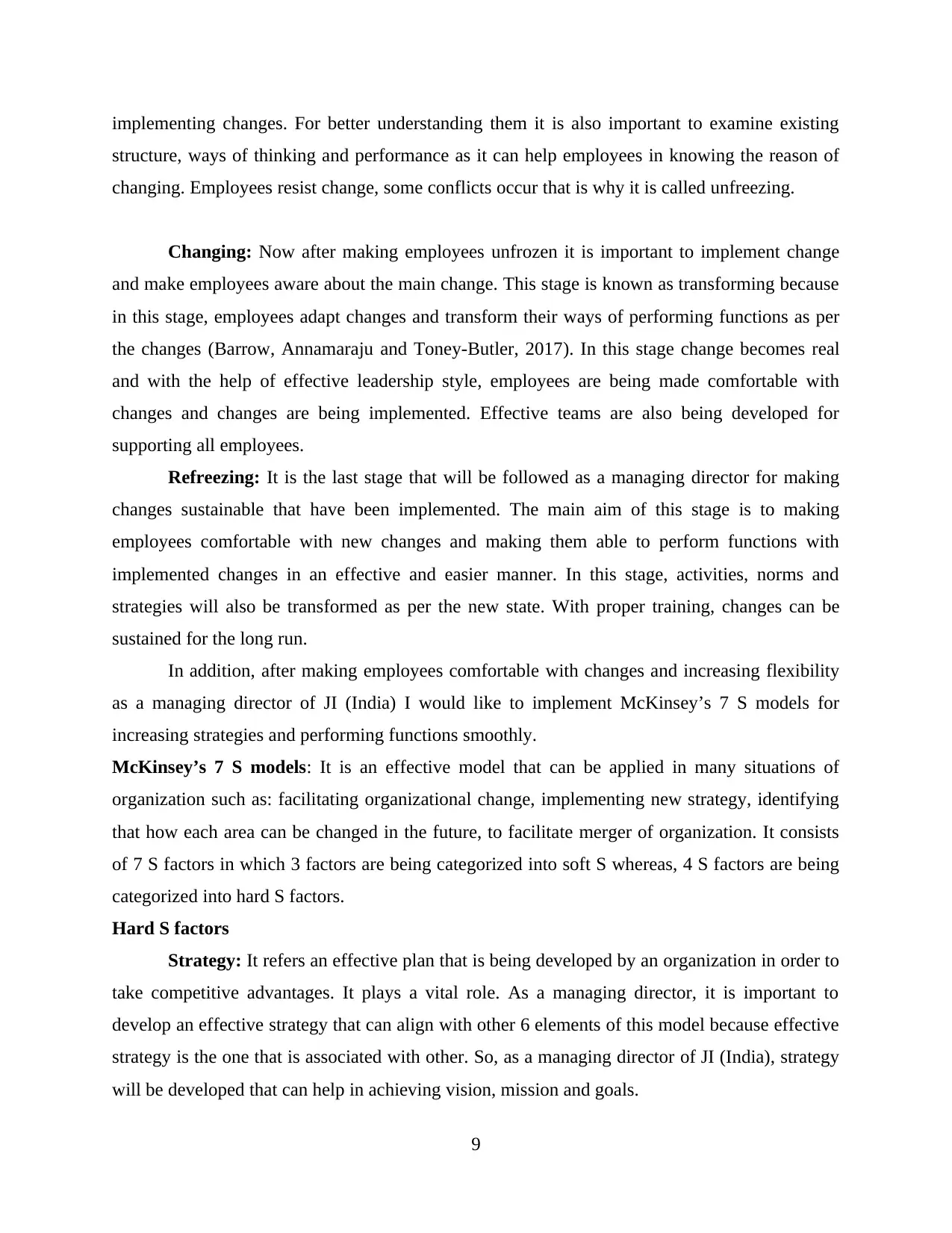
implementing changes. For better understanding them it is also important to examine existing
structure, ways of thinking and performance as it can help employees in knowing the reason of
changing. Employees resist change, some conflicts occur that is why it is called unfreezing.
Changing: Now after making employees unfrozen it is important to implement change
and make employees aware about the main change. This stage is known as transforming because
in this stage, employees adapt changes and transform their ways of performing functions as per
the changes (Barrow, Annamaraju and Toney-Butler, 2017). In this stage change becomes real
and with the help of effective leadership style, employees are being made comfortable with
changes and changes are being implemented. Effective teams are also being developed for
supporting all employees.
Refreezing: It is the last stage that will be followed as a managing director for making
changes sustainable that have been implemented. The main aim of this stage is to making
employees comfortable with new changes and making them able to perform functions with
implemented changes in an effective and easier manner. In this stage, activities, norms and
strategies will also be transformed as per the new state. With proper training, changes can be
sustained for the long run.
In addition, after making employees comfortable with changes and increasing flexibility
as a managing director of JI (India) I would like to implement McKinsey’s 7 S models for
increasing strategies and performing functions smoothly.
McKinsey’s 7 S models: It is an effective model that can be applied in many situations of
organization such as: facilitating organizational change, implementing new strategy, identifying
that how each area can be changed in the future, to facilitate merger of organization. It consists
of 7 S factors in which 3 factors are being categorized into soft S whereas, 4 S factors are being
categorized into hard S factors.
Hard S factors
Strategy: It refers an effective plan that is being developed by an organization in order to
take competitive advantages. It plays a vital role. As a managing director, it is important to
develop an effective strategy that can align with other 6 elements of this model because effective
strategy is the one that is associated with other. So, as a managing director of JI (India), strategy
will be developed that can help in achieving vision, mission and goals.
9
structure, ways of thinking and performance as it can help employees in knowing the reason of
changing. Employees resist change, some conflicts occur that is why it is called unfreezing.
Changing: Now after making employees unfrozen it is important to implement change
and make employees aware about the main change. This stage is known as transforming because
in this stage, employees adapt changes and transform their ways of performing functions as per
the changes (Barrow, Annamaraju and Toney-Butler, 2017). In this stage change becomes real
and with the help of effective leadership style, employees are being made comfortable with
changes and changes are being implemented. Effective teams are also being developed for
supporting all employees.
Refreezing: It is the last stage that will be followed as a managing director for making
changes sustainable that have been implemented. The main aim of this stage is to making
employees comfortable with new changes and making them able to perform functions with
implemented changes in an effective and easier manner. In this stage, activities, norms and
strategies will also be transformed as per the new state. With proper training, changes can be
sustained for the long run.
In addition, after making employees comfortable with changes and increasing flexibility
as a managing director of JI (India) I would like to implement McKinsey’s 7 S models for
increasing strategies and performing functions smoothly.
McKinsey’s 7 S models: It is an effective model that can be applied in many situations of
organization such as: facilitating organizational change, implementing new strategy, identifying
that how each area can be changed in the future, to facilitate merger of organization. It consists
of 7 S factors in which 3 factors are being categorized into soft S whereas, 4 S factors are being
categorized into hard S factors.
Hard S factors
Strategy: It refers an effective plan that is being developed by an organization in order to
take competitive advantages. It plays a vital role. As a managing director, it is important to
develop an effective strategy that can align with other 6 elements of this model because effective
strategy is the one that is associated with other. So, as a managing director of JI (India), strategy
will be developed that can help in achieving vision, mission and goals.
9
⊘ This is a preview!⊘
Do you want full access?
Subscribe today to unlock all pages.

Trusted by 1+ million students worldwide
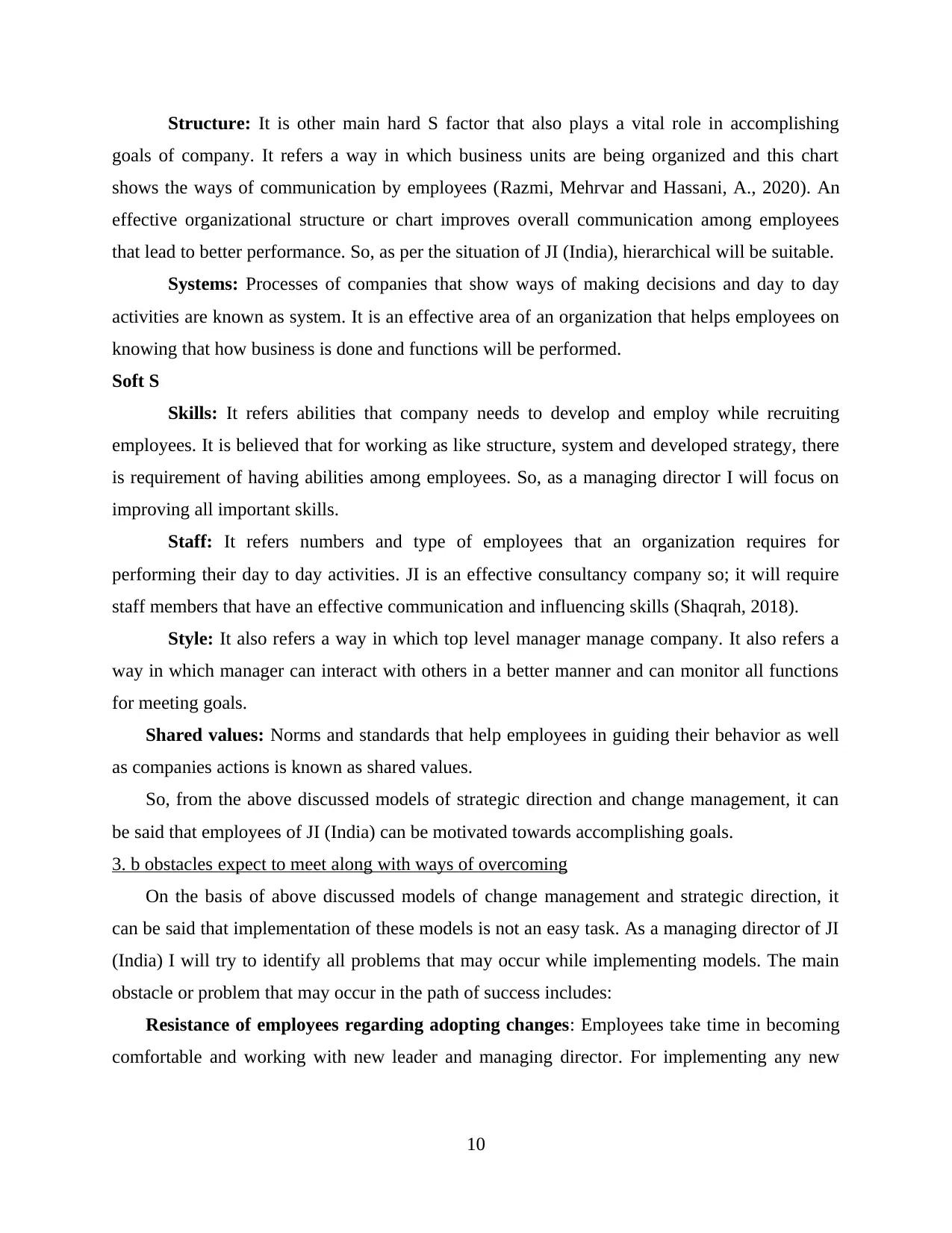
Structure: It is other main hard S factor that also plays a vital role in accomplishing
goals of company. It refers a way in which business units are being organized and this chart
shows the ways of communication by employees (Razmi, Mehrvar and Hassani, A., 2020). An
effective organizational structure or chart improves overall communication among employees
that lead to better performance. So, as per the situation of JI (India), hierarchical will be suitable.
Systems: Processes of companies that show ways of making decisions and day to day
activities are known as system. It is an effective area of an organization that helps employees on
knowing that how business is done and functions will be performed.
Soft S
Skills: It refers abilities that company needs to develop and employ while recruiting
employees. It is believed that for working as like structure, system and developed strategy, there
is requirement of having abilities among employees. So, as a managing director I will focus on
improving all important skills.
Staff: It refers numbers and type of employees that an organization requires for
performing their day to day activities. JI is an effective consultancy company so; it will require
staff members that have an effective communication and influencing skills (Shaqrah, 2018).
Style: It also refers a way in which top level manager manage company. It also refers a
way in which manager can interact with others in a better manner and can monitor all functions
for meeting goals.
Shared values: Norms and standards that help employees in guiding their behavior as well
as companies actions is known as shared values.
So, from the above discussed models of strategic direction and change management, it can
be said that employees of JI (India) can be motivated towards accomplishing goals.
3. b obstacles expect to meet along with ways of overcoming
On the basis of above discussed models of change management and strategic direction, it
can be said that implementation of these models is not an easy task. As a managing director of JI
(India) I will try to identify all problems that may occur while implementing models. The main
obstacle or problem that may occur in the path of success includes:
Resistance of employees regarding adopting changes: Employees take time in becoming
comfortable and working with new leader and managing director. For implementing any new
10
goals of company. It refers a way in which business units are being organized and this chart
shows the ways of communication by employees (Razmi, Mehrvar and Hassani, A., 2020). An
effective organizational structure or chart improves overall communication among employees
that lead to better performance. So, as per the situation of JI (India), hierarchical will be suitable.
Systems: Processes of companies that show ways of making decisions and day to day
activities are known as system. It is an effective area of an organization that helps employees on
knowing that how business is done and functions will be performed.
Soft S
Skills: It refers abilities that company needs to develop and employ while recruiting
employees. It is believed that for working as like structure, system and developed strategy, there
is requirement of having abilities among employees. So, as a managing director I will focus on
improving all important skills.
Staff: It refers numbers and type of employees that an organization requires for
performing their day to day activities. JI is an effective consultancy company so; it will require
staff members that have an effective communication and influencing skills (Shaqrah, 2018).
Style: It also refers a way in which top level manager manage company. It also refers a
way in which manager can interact with others in a better manner and can monitor all functions
for meeting goals.
Shared values: Norms and standards that help employees in guiding their behavior as well
as companies actions is known as shared values.
So, from the above discussed models of strategic direction and change management, it can
be said that employees of JI (India) can be motivated towards accomplishing goals.
3. b obstacles expect to meet along with ways of overcoming
On the basis of above discussed models of change management and strategic direction, it
can be said that implementation of these models is not an easy task. As a managing director of JI
(India) I will try to identify all problems that may occur while implementing models. The main
obstacle or problem that may occur in the path of success includes:
Resistance of employees regarding adopting changes: Employees take time in becoming
comfortable and working with new leader and managing director. For implementing any new
10
Paraphrase This Document
Need a fresh take? Get an instant paraphrase of this document with our AI Paraphraser
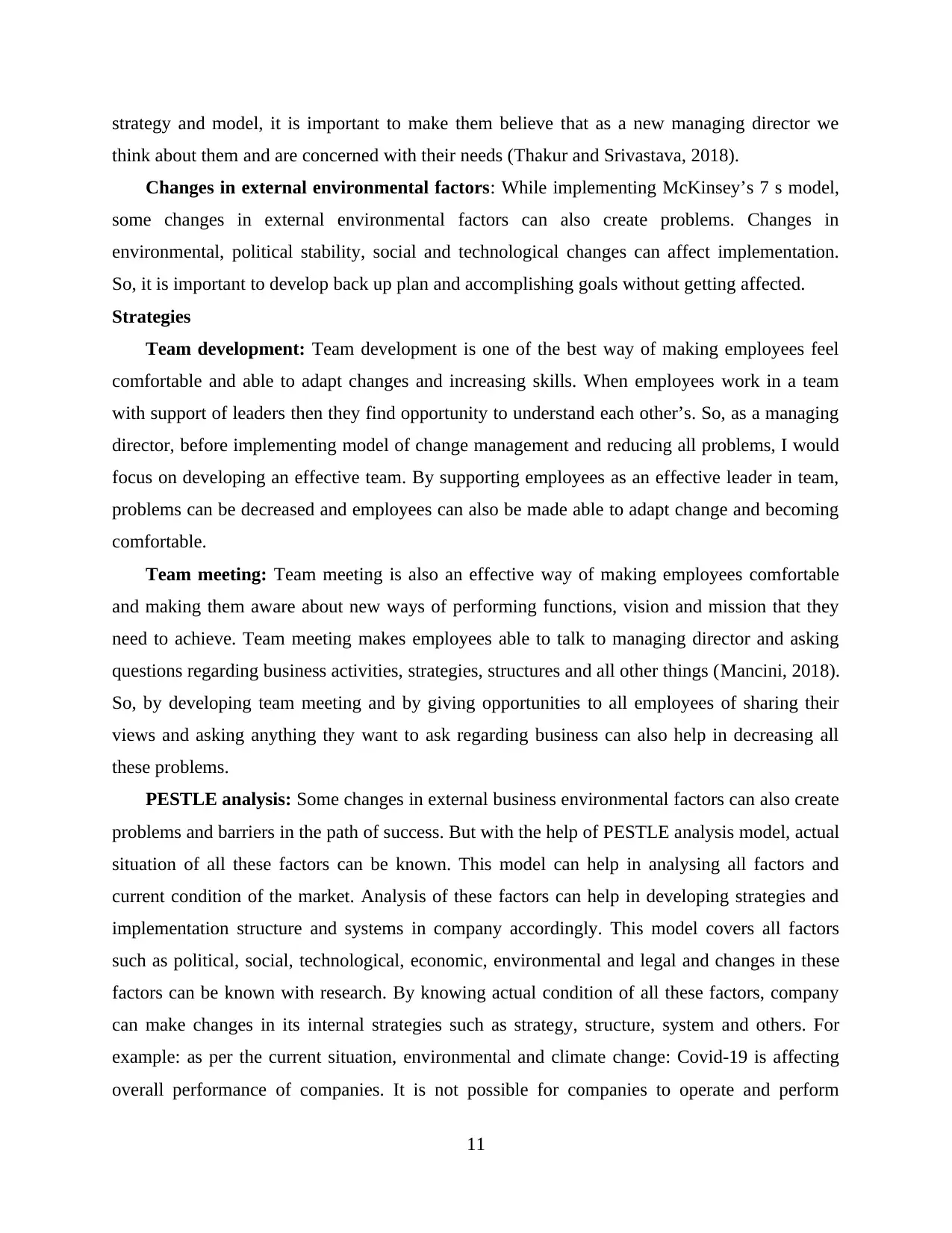
strategy and model, it is important to make them believe that as a new managing director we
think about them and are concerned with their needs (Thakur and Srivastava, 2018).
Changes in external environmental factors: While implementing McKinsey’s 7 s model,
some changes in external environmental factors can also create problems. Changes in
environmental, political stability, social and technological changes can affect implementation.
So, it is important to develop back up plan and accomplishing goals without getting affected.
Strategies
Team development: Team development is one of the best way of making employees feel
comfortable and able to adapt changes and increasing skills. When employees work in a team
with support of leaders then they find opportunity to understand each other’s. So, as a managing
director, before implementing model of change management and reducing all problems, I would
focus on developing an effective team. By supporting employees as an effective leader in team,
problems can be decreased and employees can also be made able to adapt change and becoming
comfortable.
Team meeting: Team meeting is also an effective way of making employees comfortable
and making them aware about new ways of performing functions, vision and mission that they
need to achieve. Team meeting makes employees able to talk to managing director and asking
questions regarding business activities, strategies, structures and all other things (Mancini, 2018).
So, by developing team meeting and by giving opportunities to all employees of sharing their
views and asking anything they want to ask regarding business can also help in decreasing all
these problems.
PESTLE analysis: Some changes in external business environmental factors can also create
problems and barriers in the path of success. But with the help of PESTLE analysis model, actual
situation of all these factors can be known. This model can help in analysing all factors and
current condition of the market. Analysis of these factors can help in developing strategies and
implementation structure and systems in company accordingly. This model covers all factors
such as political, social, technological, economic, environmental and legal and changes in these
factors can be known with research. By knowing actual condition of all these factors, company
can make changes in its internal strategies such as strategy, structure, system and others. For
example: as per the current situation, environmental and climate change: Covid-19 is affecting
overall performance of companies. It is not possible for companies to operate and perform
11
think about them and are concerned with their needs (Thakur and Srivastava, 2018).
Changes in external environmental factors: While implementing McKinsey’s 7 s model,
some changes in external environmental factors can also create problems. Changes in
environmental, political stability, social and technological changes can affect implementation.
So, it is important to develop back up plan and accomplishing goals without getting affected.
Strategies
Team development: Team development is one of the best way of making employees feel
comfortable and able to adapt changes and increasing skills. When employees work in a team
with support of leaders then they find opportunity to understand each other’s. So, as a managing
director, before implementing model of change management and reducing all problems, I would
focus on developing an effective team. By supporting employees as an effective leader in team,
problems can be decreased and employees can also be made able to adapt change and becoming
comfortable.
Team meeting: Team meeting is also an effective way of making employees comfortable
and making them aware about new ways of performing functions, vision and mission that they
need to achieve. Team meeting makes employees able to talk to managing director and asking
questions regarding business activities, strategies, structures and all other things (Mancini, 2018).
So, by developing team meeting and by giving opportunities to all employees of sharing their
views and asking anything they want to ask regarding business can also help in decreasing all
these problems.
PESTLE analysis: Some changes in external business environmental factors can also create
problems and barriers in the path of success. But with the help of PESTLE analysis model, actual
situation of all these factors can be known. This model can help in analysing all factors and
current condition of the market. Analysis of these factors can help in developing strategies and
implementation structure and systems in company accordingly. This model covers all factors
such as political, social, technological, economic, environmental and legal and changes in these
factors can be known with research. By knowing actual condition of all these factors, company
can make changes in its internal strategies such as strategy, structure, system and others. For
example: as per the current situation, environmental and climate change: Covid-19 is affecting
overall performance of companies. It is not possible for companies to operate and perform
11
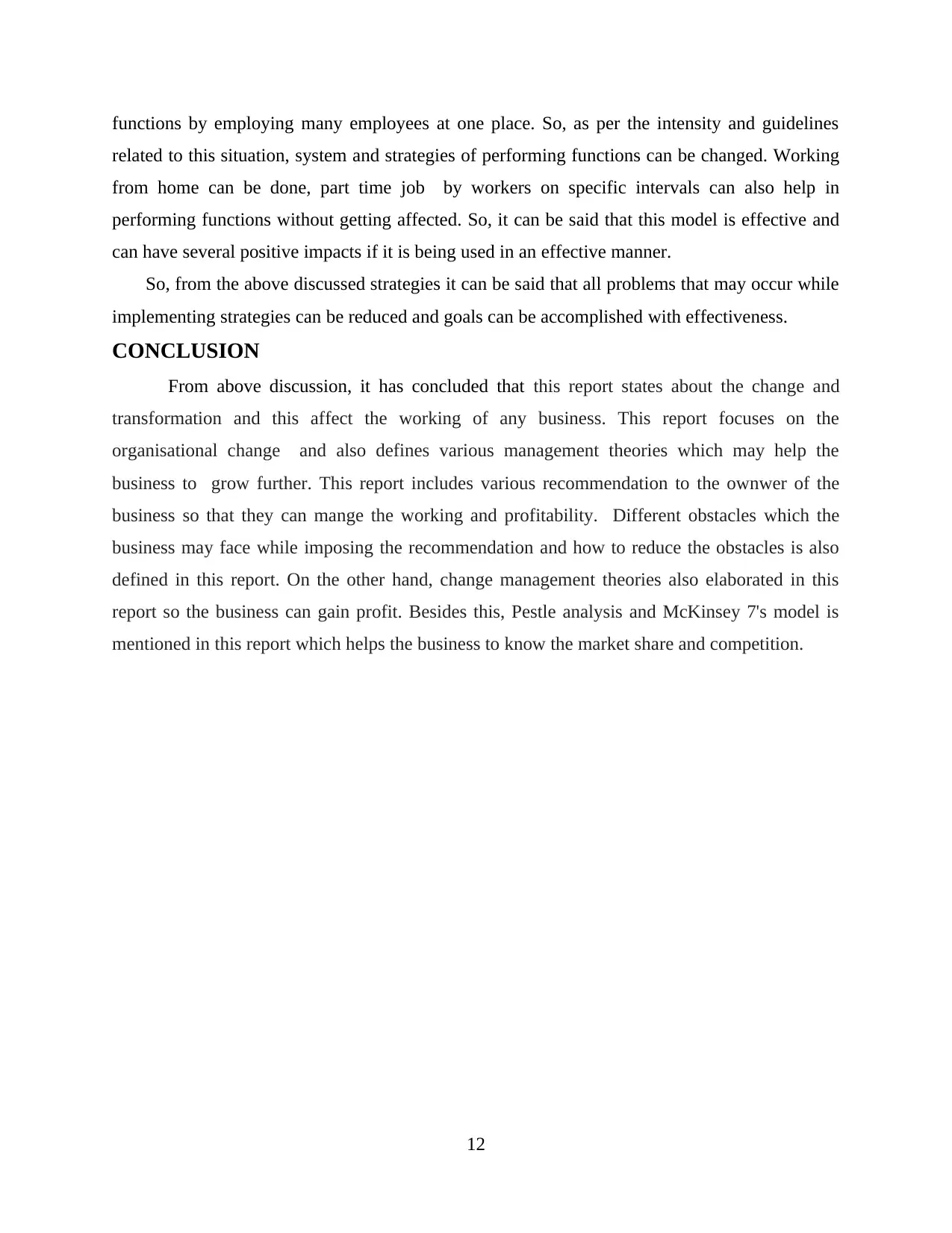
functions by employing many employees at one place. So, as per the intensity and guidelines
related to this situation, system and strategies of performing functions can be changed. Working
from home can be done, part time job by workers on specific intervals can also help in
performing functions without getting affected. So, it can be said that this model is effective and
can have several positive impacts if it is being used in an effective manner.
So, from the above discussed strategies it can be said that all problems that may occur while
implementing strategies can be reduced and goals can be accomplished with effectiveness.
CONCLUSION
From above discussion, it has concluded that this report states about the change and
transformation and this affect the working of any business. This report focuses on the
organisational change and also defines various management theories which may help the
business to grow further. This report includes various recommendation to the ownwer of the
business so that they can mange the working and profitability. Different obstacles which the
business may face while imposing the recommendation and how to reduce the obstacles is also
defined in this report. On the other hand, change management theories also elaborated in this
report so the business can gain profit. Besides this, Pestle analysis and McKinsey 7's model is
mentioned in this report which helps the business to know the market share and competition.
12
related to this situation, system and strategies of performing functions can be changed. Working
from home can be done, part time job by workers on specific intervals can also help in
performing functions without getting affected. So, it can be said that this model is effective and
can have several positive impacts if it is being used in an effective manner.
So, from the above discussed strategies it can be said that all problems that may occur while
implementing strategies can be reduced and goals can be accomplished with effectiveness.
CONCLUSION
From above discussion, it has concluded that this report states about the change and
transformation and this affect the working of any business. This report focuses on the
organisational change and also defines various management theories which may help the
business to grow further. This report includes various recommendation to the ownwer of the
business so that they can mange the working and profitability. Different obstacles which the
business may face while imposing the recommendation and how to reduce the obstacles is also
defined in this report. On the other hand, change management theories also elaborated in this
report so the business can gain profit. Besides this, Pestle analysis and McKinsey 7's model is
mentioned in this report which helps the business to know the market share and competition.
12
⊘ This is a preview!⊘
Do you want full access?
Subscribe today to unlock all pages.

Trusted by 1+ million students worldwide
1 out of 14
Related Documents
Your All-in-One AI-Powered Toolkit for Academic Success.
+13062052269
info@desklib.com
Available 24*7 on WhatsApp / Email
![[object Object]](/_next/static/media/star-bottom.7253800d.svg)
Unlock your academic potential
Copyright © 2020–2025 A2Z Services. All Rights Reserved. Developed and managed by ZUCOL.





